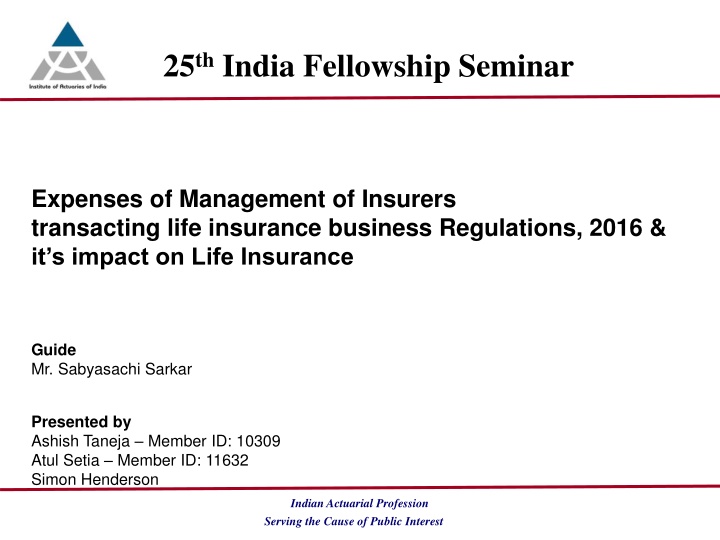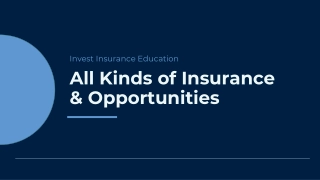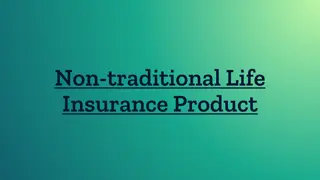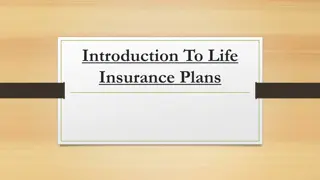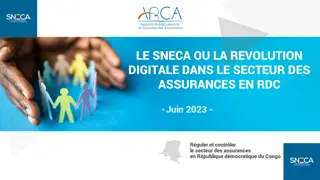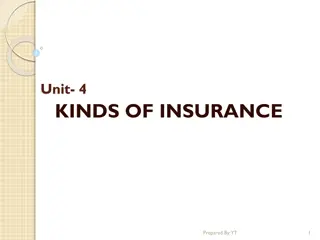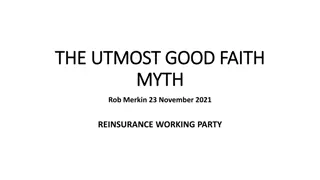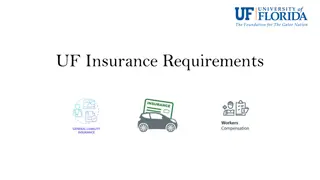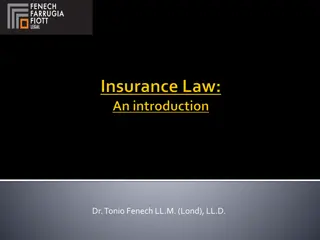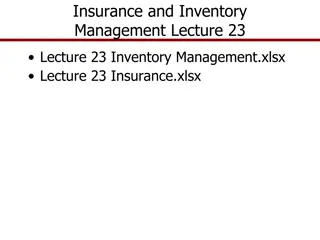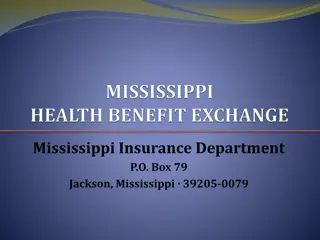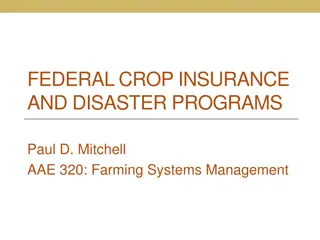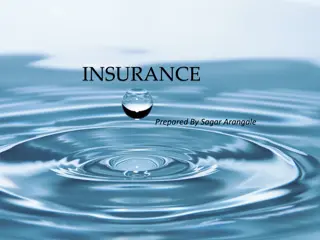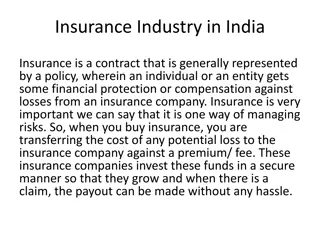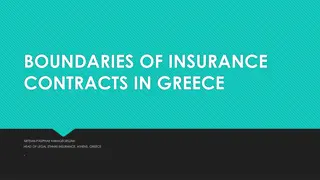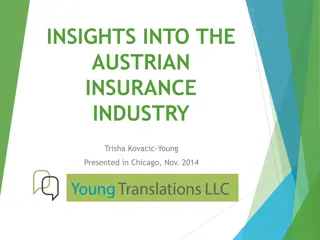Management of Life Insurance Regulations 2016 & Its Impact on Industry
This seminar discusses the regulations on management of insurers transacting life insurance business and their impact on the industry. It covers details of regulations, comparison with Rule 17.D, case studies, and global perspectives. Key milestones in insurance laws are also outlined, along with defining expenses of management and EoM limits for different types of products.
Download Presentation

Please find below an Image/Link to download the presentation.
The content on the website is provided AS IS for your information and personal use only. It may not be sold, licensed, or shared on other websites without obtaining consent from the author.If you encounter any issues during the download, it is possible that the publisher has removed the file from their server.
You are allowed to download the files provided on this website for personal or commercial use, subject to the condition that they are used lawfully. All files are the property of their respective owners.
The content on the website is provided AS IS for your information and personal use only. It may not be sold, licensed, or shared on other websites without obtaining consent from the author.
E N D
Presentation Transcript
25th India Fellowship Seminar Expenses of Management of Insurers transacting life insurance business Regulations, 2016 & it s impact on Life Insurance Guide Mr. Sabyasachi Sarkar Presented by Ashish Taneja Member ID: 10309 Atul Setia Member ID: 11632 Simon Henderson Indian Actuarial Profession Serving the Cause of Public Interest
Agenda Background Regulations in detail Comparison with Rule 17 D Impact on the Life Insurance Industry Case Study What is happening in other countries? www.actuariesindia.org 2
Agenda Background Regulations in detail Comparison with Rule 17 D Impact on the Life Insurance Industry Case Study What is happening in other countries? www.actuariesindia.org 3
Key Milestones Section 17 D, Insurance Rules, 1939 Insurance Laws (Amendment) Bill, 2008 Standing Committee Recommendations, 2011 Amendments, 2014 Exposure Draft, Dec 2015 Exposure Draft, Jan 2016 (commission change) Final Notification, May 2016 www.actuariesindia.org 5
Agenda Background Regulations in detail Comparison with Rule 17 D Impact on the Life Insurance Industry Case Study What is happening in other countries? www.actuariesindia.org 6
Defining Expenses of Management (EoM) Commission and expenses reimbursed on reinsurance inward Commission or other remuneration paid to distributor EoM limits vary by Type of product Age of life insurer Premium payment term for the product Operating Expenses Expenses of Management 7 www.actuariesindia.org
EoM limits for different types of products (1/3) Pension and Annuity products Single premium policies - 5% of all single premium Non-single premium policies - 10% of all first year s premium and 4% of all renewal premiums 0.5% of annuities paid during the year Pure risk products Single premium policies - 10% of all single premium for both Individual and Group products Non-single premium policies Limits vary by premium payment term Percentage of premiums received during the year Premium payment term (PPT) : of first year s premium of renewal premiums PPT < 10 years 7.5% * PPT 25% PPT >= 10 years 100% 25% 1/20th of 1% of average of the total sum assured for paid-up policies on which no further premiums are payable 1/100th of 1% of the total sum assured of lapsed policies under the revival period at the beginning of the year 8 www.actuariesindia.org
EoM limits for different types of products (2/3) Savings products Single premium policies - 5% of all single premium for both Individual and Group products Non-single premium policies Limits vary by premium payment term and duration of life insurer s business Percentage of premiums received during the year Duration of insurer s life insurance business of first year s premium of renewal premiums : First 10 years of operation PPT < 5 years 7.5% * PPT 18% 5 years <=PPT <= 7 years 70% 18% 8 years <= PPT <= 9 years 80% 19% PPT >= 10 years 90% 20% After 10 years of operation PPT < 5 years 7.5% * PPT 15% 5 years <=PPT <= 7 years 60% 15% 8 years <= PPT <= 9 years 70% 15% PPT >= 10 years 80% 15% 1/20th of 1% of average of the total sum assured for paid-up policies on which no further premiums are payable 1/100th of 1% of the total sum assured of lapsed policies under the revival period at the beginning of the year www.actuariesindia.org 9
EoM limits for different types of products (3/3) One year renewable group products (other than group fund based policies) 15% of all premiums received during the year Fund based group products Average of asset under management (AUM) at the beginning and end of the year Allowable expenses of management : Up to Rs. 10,000 Crores 1.00% In excess of Rs. 10,000 Crores 0.80% www.actuariesindia.org 10
Documentation requirement Board approved policy for allocation of direct expenses and apportionment of indirect expenses of management amongst various business segments Allocation and Apportionment of Expenses of Management Appointed Actuary and the Chief Financial Officer have the responsibility to allocate and apportion the expenses of management in accordance with the Board approved policy All insurers need to submit the Return of Expenses of Management in a prescribed format at the end of each financial year Return of Expense of Management Return shall be signed by the Chief Executive Officer, the Chief Financial Officer and the Chief Compliance Officer of the Insurer and shall be certified by the Statutory Auditor and reviewed by the Audit Committee Statement of Expenses of Management duly approved by the Board, shall be filed with the Authority www.actuariesindia.org 11
Power to Exempt and Action for Non-compliance (1/2) Newly registered insurer may exercise forbearance up to ten years Power to exempt In case of non-compliance post ten years, regulator may direct Insurer to charge the expenses above the allowable limit to the Shareholders Account only if representation is made by the insurer with details on business plan and time period required for compliance Split into linked and non-linked Non-linked further split into non-participating and participating Segment level monitoring by the Authority Each category to split expense based on business being Life, General Annuity / Pension, Health & Variable Variable insurance shall be further segregated into Life, General Annuity and Pension and Health where any such segment contributes ten percent or more of the total Premium of an insurer Any other class as specified by regulator www.actuariesindia.org 12
Power to Exempt and Action for Non-compliance (2/2) Excess to be charged to Shareholders Account Restriction on performance incentive to management Restriction on opening of new places of business Action for non- compliance Graded Penal action under section 102 of the Act Removal of Managerial Personnel and / or appointment of Administrator Any other action as specified in the Act For FY 2015-16, Insurers have the option either to comply with these Regulations or with the provisions of Rule 17D of the Insurance Rules, 1939 From the financial year 2016-17 onwards, all insurers shall comply with these Regulations Transitional Provisions Financial Year % Actual expenses to allowable expenses 2015-16 & 2016-17 120% 2017-18 110% 2018-19 Not above 100% www.actuariesindia.org 13
Suggested compliance process Governance The Expense analysis needs to be regularly reviewed and discussed Finance and Actuarial personnel and relevant stakeholders expense categorization and allowable expenses review the expenses allocation methodology across business segment products, sales channels and head office throughout the year Provide feed back to the Chief Actuary, CFO, and Audit committee Quarterly review and discussion of expense statements Expense allocation methodology Yearly review of expense overrun elimination target www.actuariesindia.org 14
Suggested compliance process Considerations for modelling Salary and all salary related costs, Property costs (rents, property taxes, air conditioning and other maintenance costs, cleaning costs, upkeep costs as applicable - with allowance for inflation as per lease or other agreements as relevant), System costs (initial, maintenance, enhancements and any other servicing costs with suitable inflation) Marketing and branding costs Any one-off capital costs - amortized Further categorise /group New Business and Policy Issuance costs Claim costs allocated basis the Claims Rest of the expenses allocated basis the GWP www.actuariesindia.org 15
Suggested compliance process Considerations for modelling Grouping of the expenses based on the nature of expenses (e.g. Salary, Rent & occupancy etc.) To arrive at the total cost expense line-item wise for various departments and channel. The various departments are aggregated into broad categories which include Distribution Expenses (Premium based) Corporate Cost (Policy based) which primarily consists of head-office functions New business and maintenance costs Underwriting related ( SA based) Claims related ( Claims based) Product marketing related (GWP based) Certain common costs are allocated basis across the other functions; such as Occupancy cost Weighted average of square feet used per person HR cost Headcount Training cost - Weighted average of training cost per This allows the costs to be allocated to the correct policy and area to the schedules www.actuariesindia.org 16
Agenda Background Regulations in detail Comparison with Rule 17 D Impact on the Life Insurance Industry Case Study What is happening in other countries? www.actuariesindia.org 17
Comparison with rule 17 D (1/2) Setting limits on management expenses at line of business (LoB) or segment level in addition to only aggregate company level as required by rule 17 D Expense limits is similar to those under the 17 D rules, with higher expense allowances for shorter premium payment term products and lower expense limit for longer premium payment term products Higher accountability on the Board of Directors and Statutory Auditors towards allocation of expenses Provision for stricter actions for non-compliance EoM limits for pension and annuity business have been reduced with reduction (0.5% as 1.0% earlier) in limit as % of annuity amount Separate higher limits introduced for pure risk policies www.actuariesindia.org 18
Comparison with rule 17D (2/2) Comparison of Expense limits for savings product other than single premium products EoM regulations, 2016 Rule 17 D Duration of insurer s life insurance business % of first year s premium % of renewal premiums % of first year s premium % of renewal premiums First 10 years of operation PPT < 5 years 7.5% * PPT 18% 7.5% * PPT 18% - 20% 5 years <=PPT <= 7 years 70% 18% 37.5% - 52.5% 18% - 20% 8 years <= PPT <= 9 years 80% 19% 60% - 67.5% 18% - 20% 10 years <= PPT <= 11 years 90% 19% 75% - 82.5% 18% - 20% PPT >= 12 years 90% 20% 93% - 100% 18% - 20% After 10 years of operation PPT < 5 years 7.5% * PPT 15% 7.5% * PPT 15% - 18% 5 years <=PPT <= 7 years 60% 15% 37.5% - 52.5% 15% - 18% 8 years <= PPT <= 9 years 70% 15% 60% - 67.5% 15% - 18% 10 years <= PPT <= 11 years 80% 15% 75% - 82.5% 15% - 18% PPT >= 12 years 80% 15% 90% 15% - 18% www.actuariesindia.org 19
Agenda Background Regulations in detail Comparison with Rule 17 D Impact on the Life Insurance Industry Case Study What is happening in other countries? www.actuariesindia.org 20
Key Impacts on the Industry Product portfolio mix (by product type and premium payment term (PPT)) may undergo change to ensure compliance with the EoM limits Impact on products being offered by Life Insurers Proportion of sales through short pay variants (PPT < 10 years) are likely to increase/prevail on account of higher expense limits in comparison to Rule 17 D For participating business Any expenses beyond EoM limit will have to be charged to Shareholders rather then being debited to asset share (90:10 share between Policyholder and Shareholder) Proportion of sales through pure risk products might increase on account of higher expense limits Expense limits for pension and annuity business continues to be low - Segment wise compliance means that doing this business has become even tougher The current top insurers are likely to be compatible with the EoM limits both on an aggregate basis and on a line of business/segment basis resulting in no or minimal impact on Shareholders profits Impact on Shareholders profits / overruns The next tier of insurers, especially those selling a greater proportion of single premium or other fund based group products could fall foul Small players with no bancassurance tie-ups are likely to suffer even more www.actuariesindia.org 21
Key Impacts on the Industry Significant Agency dependent insurers will go aggressive on acquiring new bancassurance tie-up to manage the overall compliance; may lead to increase in overall acquisition cost Impact on Distribution Channels Commission structure for distributor may undergo change to keep a check on overall acquisition cost In short term, the proportion of business through cost heavy Agency or other channels might reduce leading to further increase in dependence on bancassurance as a distribution channel Focus on growth and development of cost effective channels like Online channel is likely to increase In the short term, EoM limits would make business tougher for smaller and high Agency dependent players Overall impact Focus on cost control will increase significantly Focus on improving persistency will increase further to enhance the renewal premium income to subsidise higher acquisition expenses Lower expense loadings could enhance the returns to customers leading to overall growth of industry www.actuariesindia.org 22
Agenda Background Regulations in detail Comparison with Rule 17 D Impact on the Life Insurance Industry Case Study What is happening in other countries? www.actuariesindia.org 23
Case Study - Singapore The Financial Advisory Industry Review - FAIR Capping first year commission Re-distributing payouts over reasonable premium payment terms Adopting a Balanced Scorecard (BSC) Framework which include non-sales KPIs to encourage agents to act in he best interest of the customer Banning product specific incentives Strengthening accountability of the Board and senior management www.actuariesindia.org 24
South African environment Life insurance industry similar development as India Legislation issued by the National Treasury All insurance other than Health care Demarcation to delineate the boundaries between the cover Implemented via the Financial Services Board (FSB) There is no specific regulation/law guiding the level of management expenses the statutory actuary and the audit committee are required to maintain suitability note: the auditors generally will review the expenses assumptions including levels and allocations allocation of expenses to lines on business usually via a functional costing framework Under relevant International Accounting Standard (IAS) E.g.IAS 39 www.actuariesindia.org 25
South African environment General tenant guiding the policy development and expenses would be Treating Customers Fairly (TCF) hence the expenses should be such that they are fair to the policyholder www.actuariesindia.org 26
Case Study Malaysia Life Insurance & Family Takaful Framework Timeline Strengthening practices market Gradual removal of limits on operating costs Diversification of distribution channels Phase 1 Improve access to life insurance & takaful products financial advisors Remove limits on management expenses and agency financing scheme 2016 Pilot implementation of the BSC Availability of online account facilities Introduction of service guide for customers 2017 Build presence of direct channels by offering commission free term insurance Align bancassurance limits for commissions with that of corporate agents Remove limits for commissions of term insurance/takaful Implementation of enhanced product disclosures in sales illustrations 2018 Build presence of direct channels by offering commission free CI and medical & health insurance Actual implementation of the BSC Remove limits for commissions of CI and medical & health insurance/takaful 2019 Remove limits on commissions and ARE with MAR for IL Phase 2 Remove limits on commissions and ARE for other ordinary life insurance/family takaful and annuity www.actuariesindia.org 27
Thank You www.actuariesindia.org 28
Appendix 1: Expense Ratios for top life insurance companies (by market share as at Dec 15) Expenses of Management (EoM) to Gross Premium Ratios 45% 40% 35% 30% 25% 20% 15% 10% 5% 0% LIC ICICI Pru HDFC Life SBI Life Max Life Birla Sunlife Bajaj Allianz Reliance Life Kotak Life PNB MetLife Exide Life FY 15 - Apr to Dec '14 FY 16 - Apr to Dec '15 Source Public Disclosures www.actuariesindia.org 29
Appendix 2 (1/3) Global Pension Assets Where do we stand? ~ 15% Source: https://www.towerswatson.com/en/Insights/IC-Types/Survey-Research-Results/2015/02/Global-Pensions-Asset-Study-2015 www.actuariesindia.org 30
Appendix 2 (2/3) Indian Demography vs Declining Pension Age Distribution of Indian Population Pension as a % of Individual NB Premium 32% 19% 11% 8% 7% 24% 15 - 59 years 23% 0 - 14 years 25% 60 years and above 36% 57% 63% 64% 20% 29% 61% 2% 2% 1% 1% 2008-09 2009-10 2010-11 2011-12 2012-13 2013-14 2014-15 Source: Population Division and Central Statistics Office Ministry of Statistics & Programme Implementation Government of India Source: Life Council New Business Performance www.actuariesindia.org 31
Appendix 2 (3/3) Individual Life vs Individual Pension Components of CoA for individual life Individual Pension Individual Life contract Direct Expenses Directly attributable Rent Medical Marketing Training Others Operations Expenses Stamp Duty Underwriting Others - Not applicable for individual pension www.actuariesindia.org 32
